Nursing Leadership in Healthcare: Analysis of 'Saving Private Ryan'
VerifiedAdded on 2023/06/07
|11
|3270
|176
Essay
AI Summary
This essay explores nursing leadership principles through an analysis of Captain John Miller's character in the film 'Saving Private Ryan.' It identifies key leadership attributes such as courage, honesty, charisma, and respect, and examines how Miller's transformational and situational leadership styles influenced his team's culture and mission success. The essay discusses the relevance of these leadership qualities to nursing and healthcare organizations, emphasizing how transformational leadership can resolve conflicts, improve nursing outcomes, and enhance patient care. It highlights the importance of respect, understanding, courage, and honesty in nursing practice, drawing parallels between Miller's leadership in the film and effective leadership in healthcare settings.

Nursing Leadership 1
NURSING LEADERSHIP
By
Student
Name
Course
Instructor
Institution
Date
NURSING LEADERSHIP
By
Student
Name
Course
Instructor
Institution
Date
Paraphrase This Document
Need a fresh take? Get an instant paraphrase of this document with our AI Paraphraser
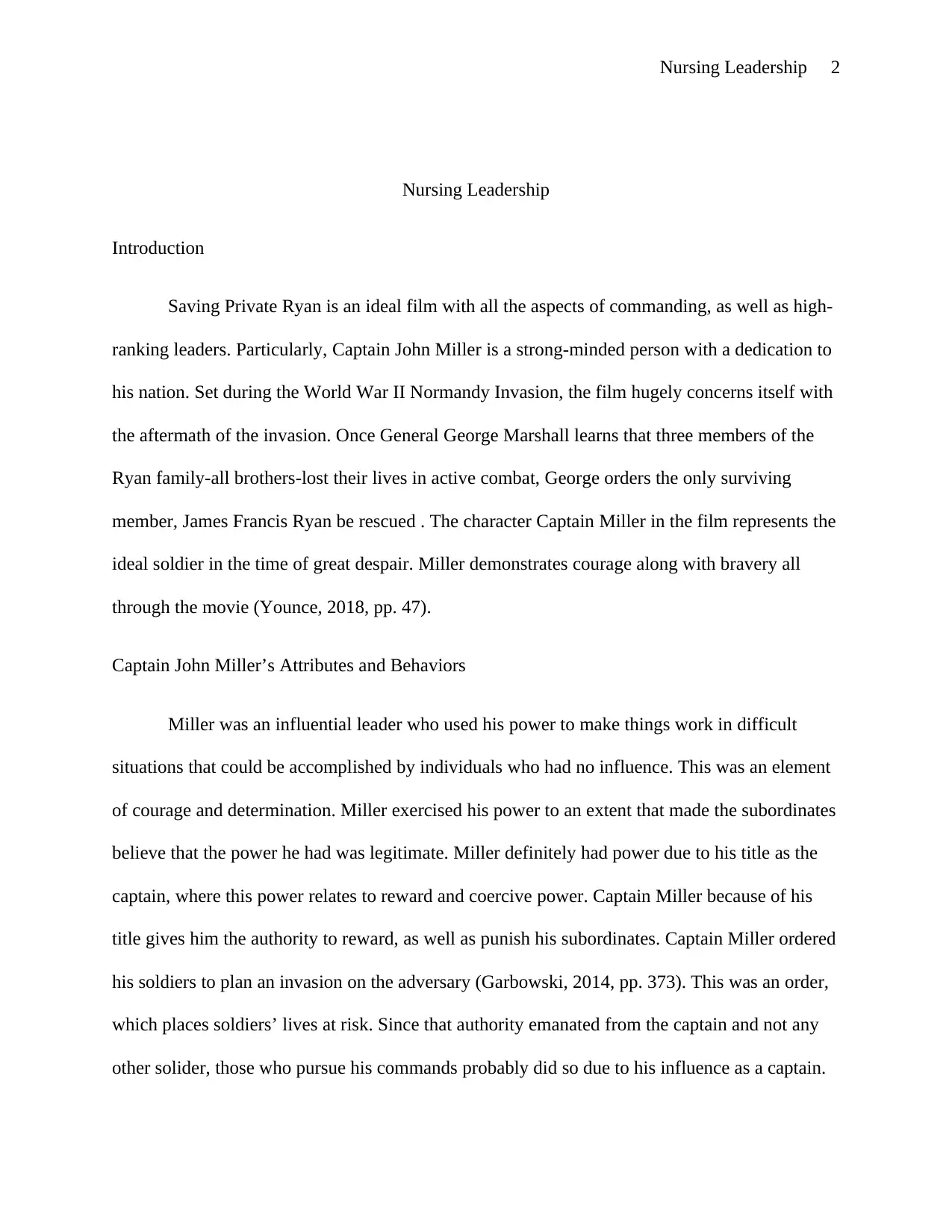
Nursing Leadership 2
Nursing Leadership
Introduction
Saving Private Ryan is an ideal film with all the aspects of commanding, as well as high-
ranking leaders. Particularly, Captain John Miller is a strong-minded person with a dedication to
his nation. Set during the World War II Normandy Invasion, the film hugely concerns itself with
the aftermath of the invasion. Once General George Marshall learns that three members of the
Ryan family-all brothers-lost their lives in active combat, George orders the only surviving
member, James Francis Ryan be rescued . The character Captain Miller in the film represents the
ideal soldier in the time of great despair. Miller demonstrates courage along with bravery all
through the movie (Younce, 2018, pp. 47).
Captain John Miller’s Attributes and Behaviors
Miller was an influential leader who used his power to make things work in difficult
situations that could be accomplished by individuals who had no influence. This was an element
of courage and determination. Miller exercised his power to an extent that made the subordinates
believe that the power he had was legitimate. Miller definitely had power due to his title as the
captain, where this power relates to reward and coercive power. Captain Miller because of his
title gives him the authority to reward, as well as punish his subordinates. Captain Miller ordered
his soldiers to plan an invasion on the adversary (Garbowski, 2014, pp. 373). This was an order,
which places soldiers’ lives at risk. Since that authority emanated from the captain and not any
other solider, those who pursue his commands probably did so due to his influence as a captain.
Nursing Leadership
Introduction
Saving Private Ryan is an ideal film with all the aspects of commanding, as well as high-
ranking leaders. Particularly, Captain John Miller is a strong-minded person with a dedication to
his nation. Set during the World War II Normandy Invasion, the film hugely concerns itself with
the aftermath of the invasion. Once General George Marshall learns that three members of the
Ryan family-all brothers-lost their lives in active combat, George orders the only surviving
member, James Francis Ryan be rescued . The character Captain Miller in the film represents the
ideal soldier in the time of great despair. Miller demonstrates courage along with bravery all
through the movie (Younce, 2018, pp. 47).
Captain John Miller’s Attributes and Behaviors
Miller was an influential leader who used his power to make things work in difficult
situations that could be accomplished by individuals who had no influence. This was an element
of courage and determination. Miller exercised his power to an extent that made the subordinates
believe that the power he had was legitimate. Miller definitely had power due to his title as the
captain, where this power relates to reward and coercive power. Captain Miller because of his
title gives him the authority to reward, as well as punish his subordinates. Captain Miller ordered
his soldiers to plan an invasion on the adversary (Garbowski, 2014, pp. 373). This was an order,
which places soldiers’ lives at risk. Since that authority emanated from the captain and not any
other solider, those who pursue his commands probably did so due to his influence as a captain.
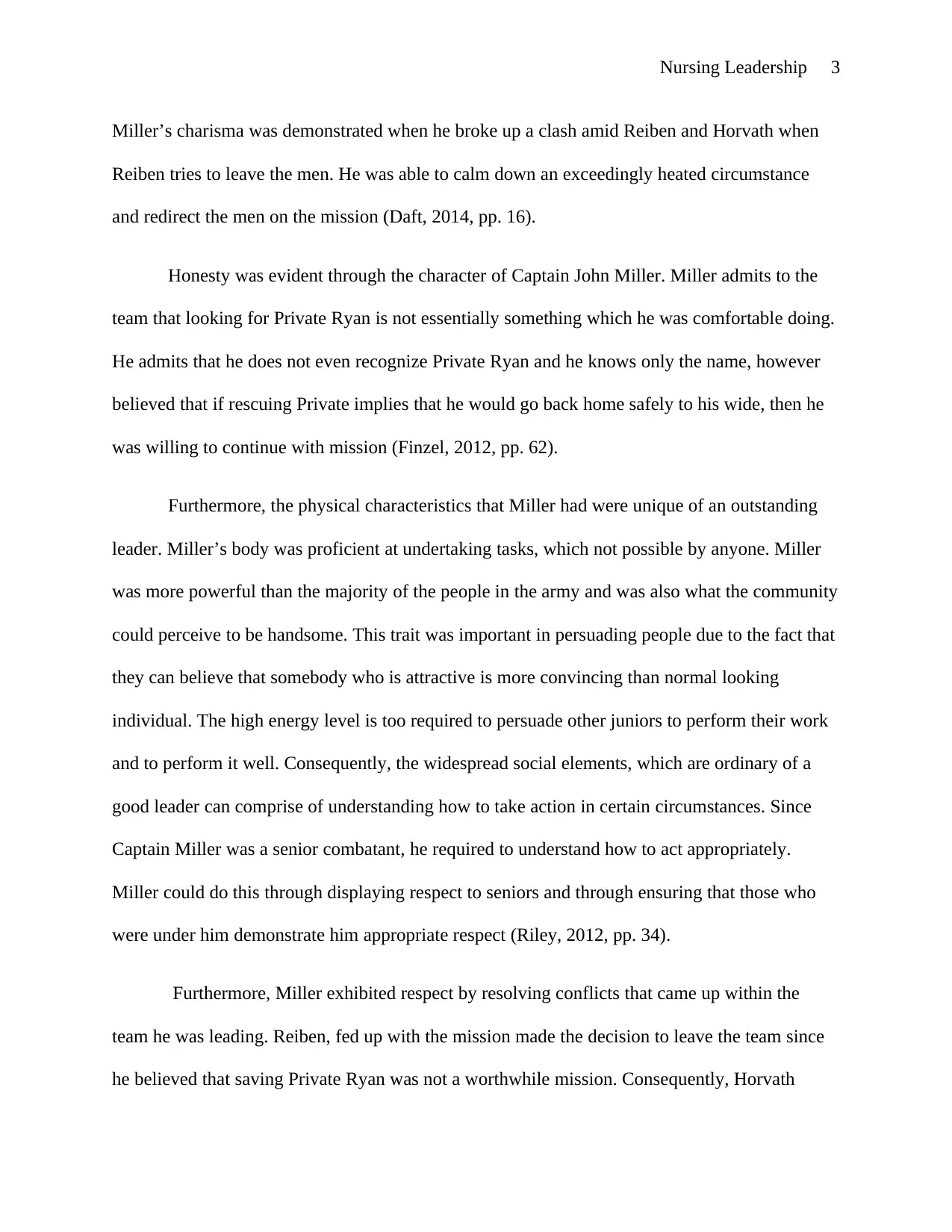
Nursing Leadership 3
Miller’s charisma was demonstrated when he broke up a clash amid Reiben and Horvath when
Reiben tries to leave the men. He was able to calm down an exceedingly heated circumstance
and redirect the men on the mission (Daft, 2014, pp. 16).
Honesty was evident through the character of Captain John Miller. Miller admits to the
team that looking for Private Ryan is not essentially something which he was comfortable doing.
He admits that he does not even recognize Private Ryan and he knows only the name, however
believed that if rescuing Private implies that he would go back home safely to his wide, then he
was willing to continue with mission (Finzel, 2012, pp. 62).
Furthermore, the physical characteristics that Miller had were unique of an outstanding
leader. Miller’s body was proficient at undertaking tasks, which not possible by anyone. Miller
was more powerful than the majority of the people in the army and was also what the community
could perceive to be handsome. This trait was important in persuading people due to the fact that
they can believe that somebody who is attractive is more convincing than normal looking
individual. The high energy level is too required to persuade other juniors to perform their work
and to perform it well. Consequently, the widespread social elements, which are ordinary of a
good leader can comprise of understanding how to take action in certain circumstances. Since
Captain Miller was a senior combatant, he required to understand how to act appropriately.
Miller could do this through displaying respect to seniors and through ensuring that those who
were under him demonstrate him appropriate respect (Riley, 2012, pp. 34).
Furthermore, Miller exhibited respect by resolving conflicts that came up within the
team he was leading. Reiben, fed up with the mission made the decision to leave the team since
he believed that saving Private Ryan was not a worthwhile mission. Consequently, Horvath
Miller’s charisma was demonstrated when he broke up a clash amid Reiben and Horvath when
Reiben tries to leave the men. He was able to calm down an exceedingly heated circumstance
and redirect the men on the mission (Daft, 2014, pp. 16).
Honesty was evident through the character of Captain John Miller. Miller admits to the
team that looking for Private Ryan is not essentially something which he was comfortable doing.
He admits that he does not even recognize Private Ryan and he knows only the name, however
believed that if rescuing Private implies that he would go back home safely to his wide, then he
was willing to continue with mission (Finzel, 2012, pp. 62).
Furthermore, the physical characteristics that Miller had were unique of an outstanding
leader. Miller’s body was proficient at undertaking tasks, which not possible by anyone. Miller
was more powerful than the majority of the people in the army and was also what the community
could perceive to be handsome. This trait was important in persuading people due to the fact that
they can believe that somebody who is attractive is more convincing than normal looking
individual. The high energy level is too required to persuade other juniors to perform their work
and to perform it well. Consequently, the widespread social elements, which are ordinary of a
good leader can comprise of understanding how to take action in certain circumstances. Since
Captain Miller was a senior combatant, he required to understand how to act appropriately.
Miller could do this through displaying respect to seniors and through ensuring that those who
were under him demonstrate him appropriate respect (Riley, 2012, pp. 34).
Furthermore, Miller exhibited respect by resolving conflicts that came up within the
team he was leading. Reiben, fed up with the mission made the decision to leave the team since
he believed that saving Private Ryan was not a worthwhile mission. Consequently, Horvath
⊘ This is a preview!⊘
Do you want full access?
Subscribe today to unlock all pages.

Trusted by 1+ million students worldwide
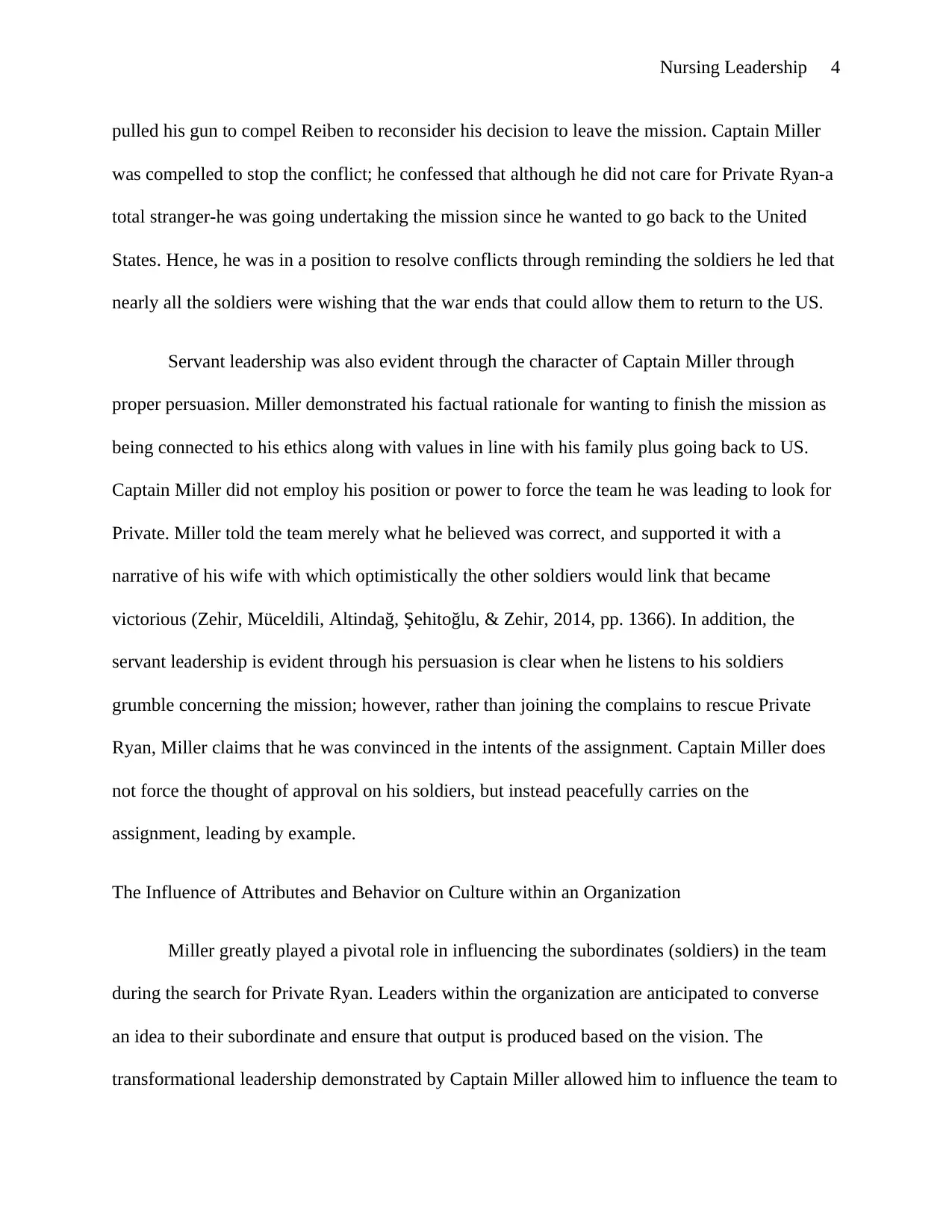
Nursing Leadership 4
pulled his gun to compel Reiben to reconsider his decision to leave the mission. Captain Miller
was compelled to stop the conflict; he confessed that although he did not care for Private Ryan-a
total stranger-he was going undertaking the mission since he wanted to go back to the United
States. Hence, he was in a position to resolve conflicts through reminding the soldiers he led that
nearly all the soldiers were wishing that the war ends that could allow them to return to the US.
Servant leadership was also evident through the character of Captain Miller through
proper persuasion. Miller demonstrated his factual rationale for wanting to finish the mission as
being connected to his ethics along with values in line with his family plus going back to US.
Captain Miller did not employ his position or power to force the team he was leading to look for
Private. Miller told the team merely what he believed was correct, and supported it with a
narrative of his wife with which optimistically the other soldiers would link that became
victorious (Zehir, Müceldili, Altindağ, Şehitoğlu, & Zehir, 2014, pp. 1366). In addition, the
servant leadership is evident through his persuasion is clear when he listens to his soldiers
grumble concerning the mission; however, rather than joining the complains to rescue Private
Ryan, Miller claims that he was convinced in the intents of the assignment. Captain Miller does
not force the thought of approval on his soldiers, but instead peacefully carries on the
assignment, leading by example.
The Influence of Attributes and Behavior on Culture within an Organization
Miller greatly played a pivotal role in influencing the subordinates (soldiers) in the team
during the search for Private Ryan. Leaders within the organization are anticipated to converse
an idea to their subordinate and ensure that output is produced based on the vision. The
transformational leadership demonstrated by Captain Miller allowed him to influence the team to
pulled his gun to compel Reiben to reconsider his decision to leave the mission. Captain Miller
was compelled to stop the conflict; he confessed that although he did not care for Private Ryan-a
total stranger-he was going undertaking the mission since he wanted to go back to the United
States. Hence, he was in a position to resolve conflicts through reminding the soldiers he led that
nearly all the soldiers were wishing that the war ends that could allow them to return to the US.
Servant leadership was also evident through the character of Captain Miller through
proper persuasion. Miller demonstrated his factual rationale for wanting to finish the mission as
being connected to his ethics along with values in line with his family plus going back to US.
Captain Miller did not employ his position or power to force the team he was leading to look for
Private. Miller told the team merely what he believed was correct, and supported it with a
narrative of his wife with which optimistically the other soldiers would link that became
victorious (Zehir, Müceldili, Altindağ, Şehitoğlu, & Zehir, 2014, pp. 1366). In addition, the
servant leadership is evident through his persuasion is clear when he listens to his soldiers
grumble concerning the mission; however, rather than joining the complains to rescue Private
Ryan, Miller claims that he was convinced in the intents of the assignment. Captain Miller does
not force the thought of approval on his soldiers, but instead peacefully carries on the
assignment, leading by example.
The Influence of Attributes and Behavior on Culture within an Organization
Miller greatly played a pivotal role in influencing the subordinates (soldiers) in the team
during the search for Private Ryan. Leaders within the organization are anticipated to converse
an idea to their subordinate and ensure that output is produced based on the vision. The
transformational leadership demonstrated by Captain Miller allowed him to influence the team to
Paraphrase This Document
Need a fresh take? Get an instant paraphrase of this document with our AI Paraphraser
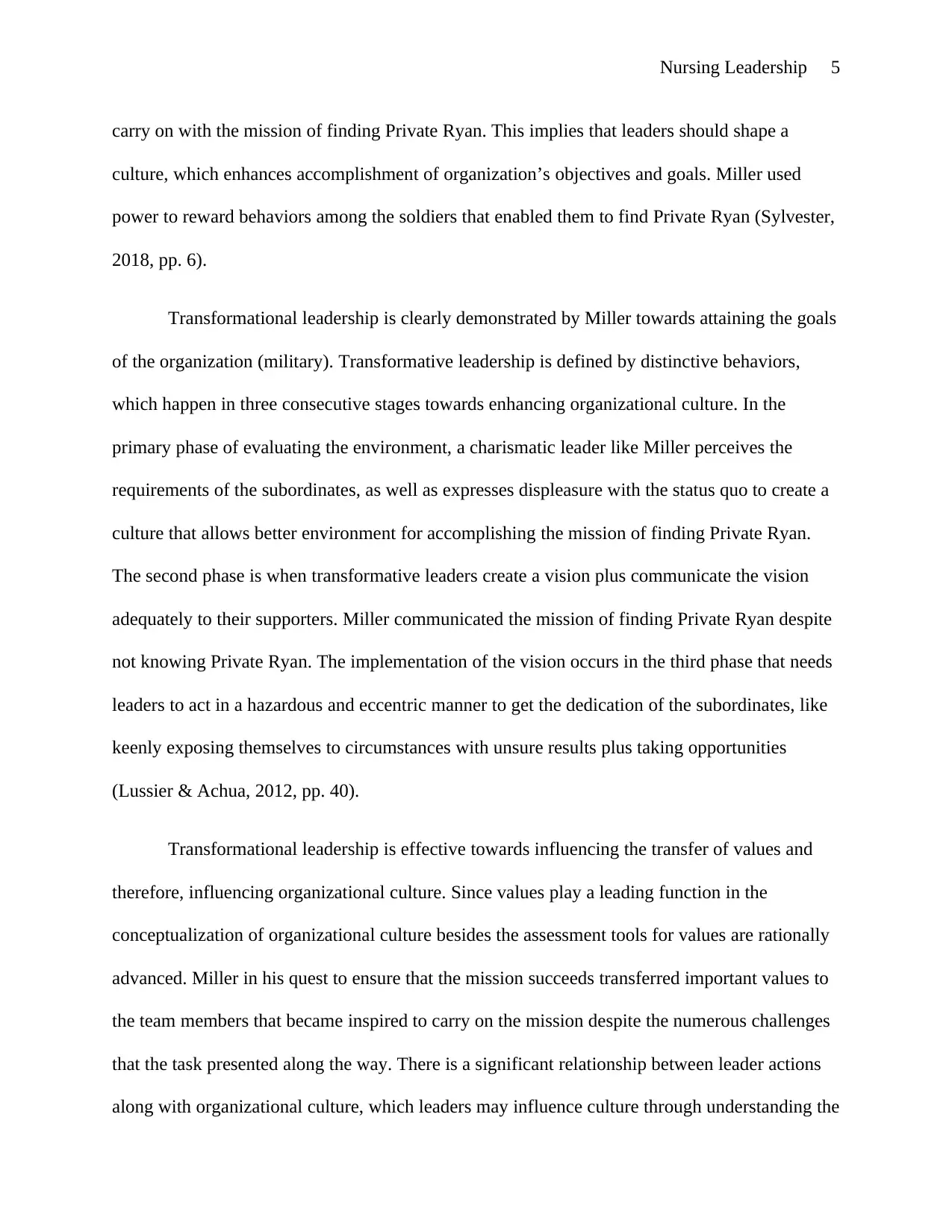
Nursing Leadership 5
carry on with the mission of finding Private Ryan. This implies that leaders should shape a
culture, which enhances accomplishment of organization’s objectives and goals. Miller used
power to reward behaviors among the soldiers that enabled them to find Private Ryan (Sylvester,
2018, pp. 6).
Transformational leadership is clearly demonstrated by Miller towards attaining the goals
of the organization (military). Transformative leadership is defined by distinctive behaviors,
which happen in three consecutive stages towards enhancing organizational culture. In the
primary phase of evaluating the environment, a charismatic leader like Miller perceives the
requirements of the subordinates, as well as expresses displeasure with the status quo to create a
culture that allows better environment for accomplishing the mission of finding Private Ryan.
The second phase is when transformative leaders create a vision plus communicate the vision
adequately to their supporters. Miller communicated the mission of finding Private Ryan despite
not knowing Private Ryan. The implementation of the vision occurs in the third phase that needs
leaders to act in a hazardous and eccentric manner to get the dedication of the subordinates, like
keenly exposing themselves to circumstances with unsure results plus taking opportunities
(Lussier & Achua, 2012, pp. 40).
Transformational leadership is effective towards influencing the transfer of values and
therefore, influencing organizational culture. Since values play a leading function in the
conceptualization of organizational culture besides the assessment tools for values are rationally
advanced. Miller in his quest to ensure that the mission succeeds transferred important values to
the team members that became inspired to carry on the mission despite the numerous challenges
that the task presented along the way. There is a significant relationship between leader actions
along with organizational culture, which leaders may influence culture through understanding the
carry on with the mission of finding Private Ryan. This implies that leaders should shape a
culture, which enhances accomplishment of organization’s objectives and goals. Miller used
power to reward behaviors among the soldiers that enabled them to find Private Ryan (Sylvester,
2018, pp. 6).
Transformational leadership is clearly demonstrated by Miller towards attaining the goals
of the organization (military). Transformative leadership is defined by distinctive behaviors,
which happen in three consecutive stages towards enhancing organizational culture. In the
primary phase of evaluating the environment, a charismatic leader like Miller perceives the
requirements of the subordinates, as well as expresses displeasure with the status quo to create a
culture that allows better environment for accomplishing the mission of finding Private Ryan.
The second phase is when transformative leaders create a vision plus communicate the vision
adequately to their supporters. Miller communicated the mission of finding Private Ryan despite
not knowing Private Ryan. The implementation of the vision occurs in the third phase that needs
leaders to act in a hazardous and eccentric manner to get the dedication of the subordinates, like
keenly exposing themselves to circumstances with unsure results plus taking opportunities
(Lussier & Achua, 2012, pp. 40).
Transformational leadership is effective towards influencing the transfer of values and
therefore, influencing organizational culture. Since values play a leading function in the
conceptualization of organizational culture besides the assessment tools for values are rationally
advanced. Miller in his quest to ensure that the mission succeeds transferred important values to
the team members that became inspired to carry on the mission despite the numerous challenges
that the task presented along the way. There is a significant relationship between leader actions
along with organizational culture, which leaders may influence culture through understanding the
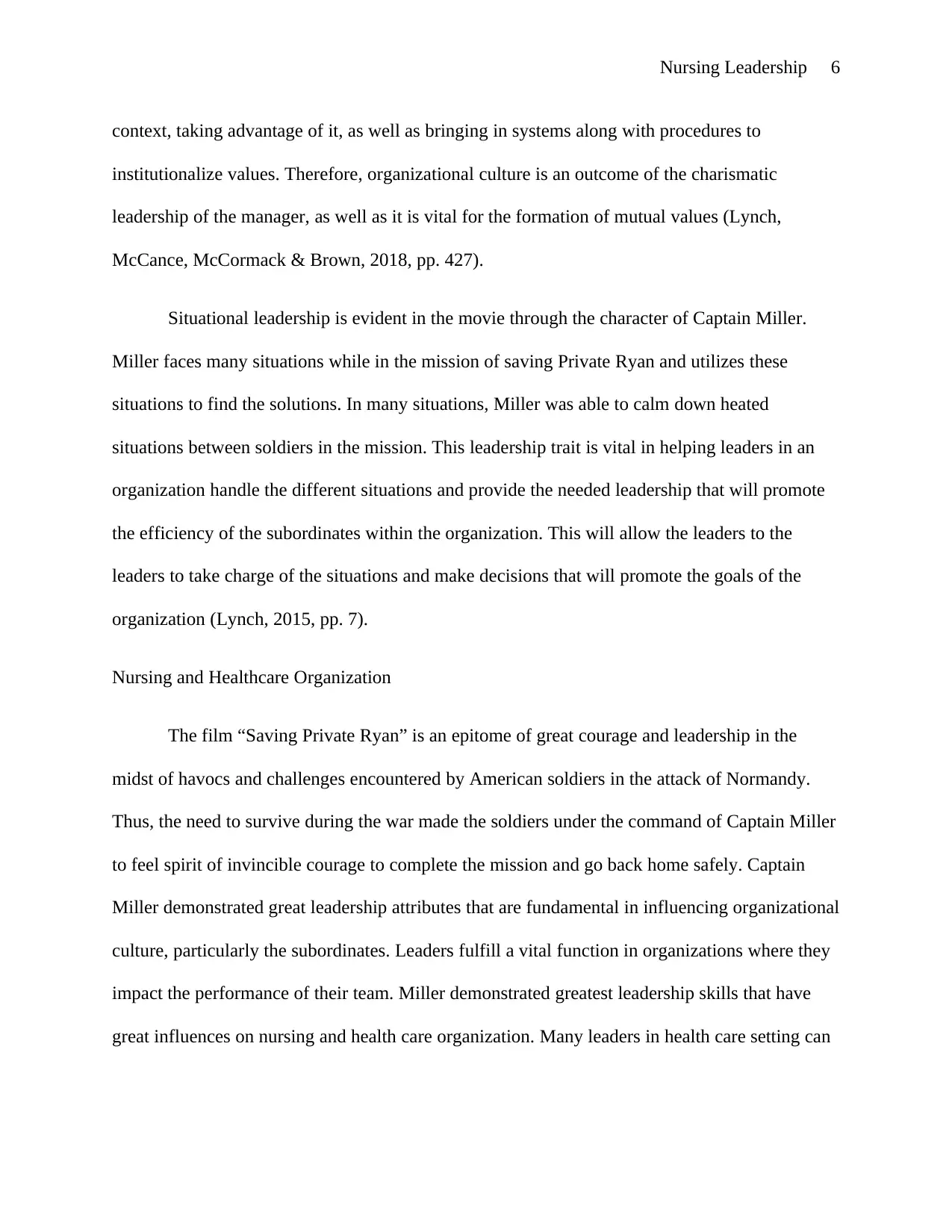
Nursing Leadership 6
context, taking advantage of it, as well as bringing in systems along with procedures to
institutionalize values. Therefore, organizational culture is an outcome of the charismatic
leadership of the manager, as well as it is vital for the formation of mutual values (Lynch,
McCance, McCormack & Brown, 2018, pp. 427).
Situational leadership is evident in the movie through the character of Captain Miller.
Miller faces many situations while in the mission of saving Private Ryan and utilizes these
situations to find the solutions. In many situations, Miller was able to calm down heated
situations between soldiers in the mission. This leadership trait is vital in helping leaders in an
organization handle the different situations and provide the needed leadership that will promote
the efficiency of the subordinates within the organization. This will allow the leaders to the
leaders to take charge of the situations and make decisions that will promote the goals of the
organization (Lynch, 2015, pp. 7).
Nursing and Healthcare Organization
The film “Saving Private Ryan” is an epitome of great courage and leadership in the
midst of havocs and challenges encountered by American soldiers in the attack of Normandy.
Thus, the need to survive during the war made the soldiers under the command of Captain Miller
to feel spirit of invincible courage to complete the mission and go back home safely. Captain
Miller demonstrated great leadership attributes that are fundamental in influencing organizational
culture, particularly the subordinates. Leaders fulfill a vital function in organizations where they
impact the performance of their team. Miller demonstrated greatest leadership skills that have
great influences on nursing and health care organization. Many leaders in health care setting can
context, taking advantage of it, as well as bringing in systems along with procedures to
institutionalize values. Therefore, organizational culture is an outcome of the charismatic
leadership of the manager, as well as it is vital for the formation of mutual values (Lynch,
McCance, McCormack & Brown, 2018, pp. 427).
Situational leadership is evident in the movie through the character of Captain Miller.
Miller faces many situations while in the mission of saving Private Ryan and utilizes these
situations to find the solutions. In many situations, Miller was able to calm down heated
situations between soldiers in the mission. This leadership trait is vital in helping leaders in an
organization handle the different situations and provide the needed leadership that will promote
the efficiency of the subordinates within the organization. This will allow the leaders to the
leaders to take charge of the situations and make decisions that will promote the goals of the
organization (Lynch, 2015, pp. 7).
Nursing and Healthcare Organization
The film “Saving Private Ryan” is an epitome of great courage and leadership in the
midst of havocs and challenges encountered by American soldiers in the attack of Normandy.
Thus, the need to survive during the war made the soldiers under the command of Captain Miller
to feel spirit of invincible courage to complete the mission and go back home safely. Captain
Miller demonstrated great leadership attributes that are fundamental in influencing organizational
culture, particularly the subordinates. Leaders fulfill a vital function in organizations where they
impact the performance of their team. Miller demonstrated greatest leadership skills that have
great influences on nursing and health care organization. Many leaders in health care setting can
⊘ This is a preview!⊘
Do you want full access?
Subscribe today to unlock all pages.

Trusted by 1+ million students worldwide
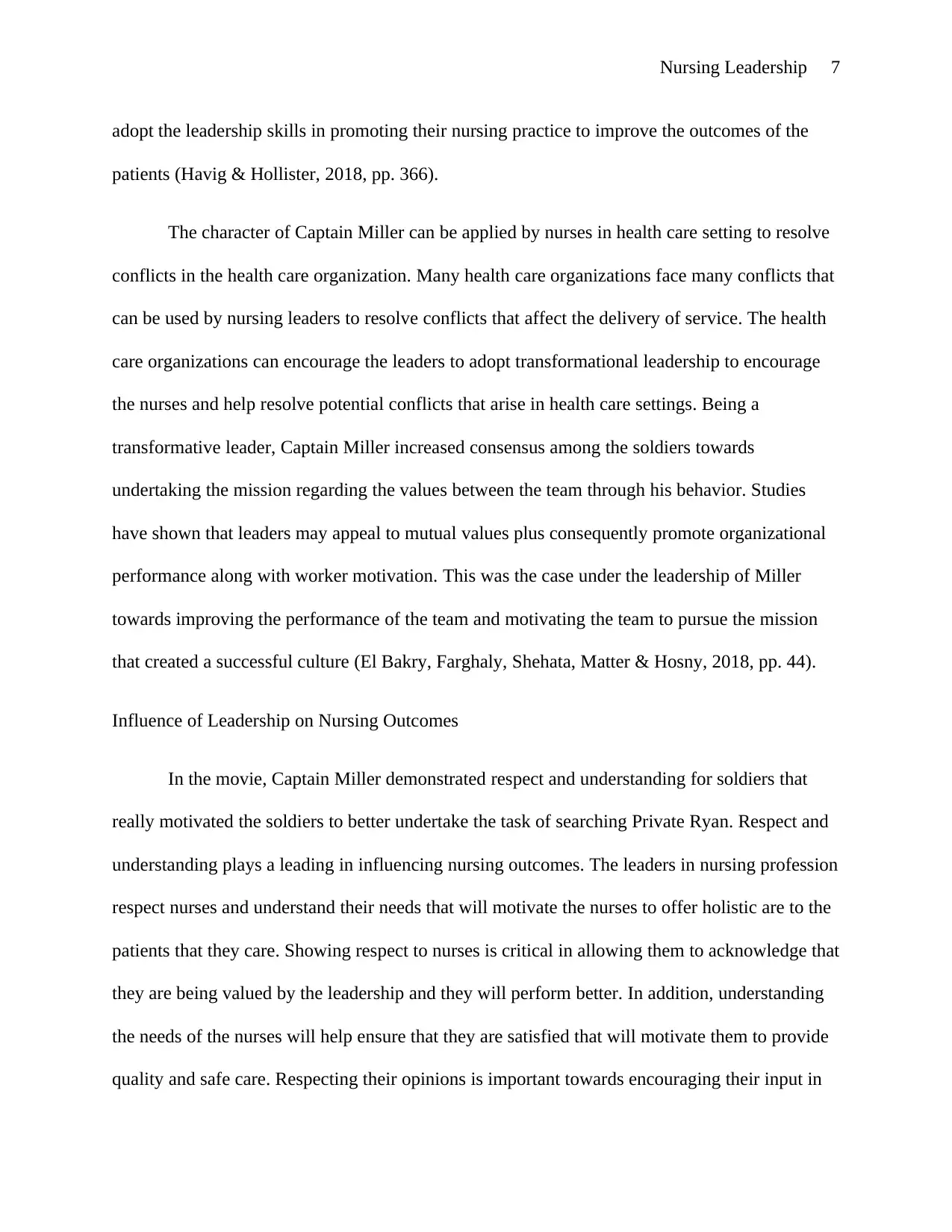
Nursing Leadership 7
adopt the leadership skills in promoting their nursing practice to improve the outcomes of the
patients (Havig & Hollister, 2018, pp. 366).
The character of Captain Miller can be applied by nurses in health care setting to resolve
conflicts in the health care organization. Many health care organizations face many conflicts that
can be used by nursing leaders to resolve conflicts that affect the delivery of service. The health
care organizations can encourage the leaders to adopt transformational leadership to encourage
the nurses and help resolve potential conflicts that arise in health care settings. Being a
transformative leader, Captain Miller increased consensus among the soldiers towards
undertaking the mission regarding the values between the team through his behavior. Studies
have shown that leaders may appeal to mutual values plus consequently promote organizational
performance along with worker motivation. This was the case under the leadership of Miller
towards improving the performance of the team and motivating the team to pursue the mission
that created a successful culture (El Bakry, Farghaly, Shehata, Matter & Hosny, 2018, pp. 44).
Influence of Leadership on Nursing Outcomes
In the movie, Captain Miller demonstrated respect and understanding for soldiers that
really motivated the soldiers to better undertake the task of searching Private Ryan. Respect and
understanding plays a leading in influencing nursing outcomes. The leaders in nursing profession
respect nurses and understand their needs that will motivate the nurses to offer holistic are to the
patients that they care. Showing respect to nurses is critical in allowing them to acknowledge that
they are being valued by the leadership and they will perform better. In addition, understanding
the needs of the nurses will help ensure that they are satisfied that will motivate them to provide
quality and safe care. Respecting their opinions is important towards encouraging their input in
adopt the leadership skills in promoting their nursing practice to improve the outcomes of the
patients (Havig & Hollister, 2018, pp. 366).
The character of Captain Miller can be applied by nurses in health care setting to resolve
conflicts in the health care organization. Many health care organizations face many conflicts that
can be used by nursing leaders to resolve conflicts that affect the delivery of service. The health
care organizations can encourage the leaders to adopt transformational leadership to encourage
the nurses and help resolve potential conflicts that arise in health care settings. Being a
transformative leader, Captain Miller increased consensus among the soldiers towards
undertaking the mission regarding the values between the team through his behavior. Studies
have shown that leaders may appeal to mutual values plus consequently promote organizational
performance along with worker motivation. This was the case under the leadership of Miller
towards improving the performance of the team and motivating the team to pursue the mission
that created a successful culture (El Bakry, Farghaly, Shehata, Matter & Hosny, 2018, pp. 44).
Influence of Leadership on Nursing Outcomes
In the movie, Captain Miller demonstrated respect and understanding for soldiers that
really motivated the soldiers to better undertake the task of searching Private Ryan. Respect and
understanding plays a leading in influencing nursing outcomes. The leaders in nursing profession
respect nurses and understand their needs that will motivate the nurses to offer holistic are to the
patients that they care. Showing respect to nurses is critical in allowing them to acknowledge that
they are being valued by the leadership and they will perform better. In addition, understanding
the needs of the nurses will help ensure that they are satisfied that will motivate them to provide
quality and safe care. Respecting their opinions is important towards encouraging their input in
Paraphrase This Document
Need a fresh take? Get an instant paraphrase of this document with our AI Paraphraser
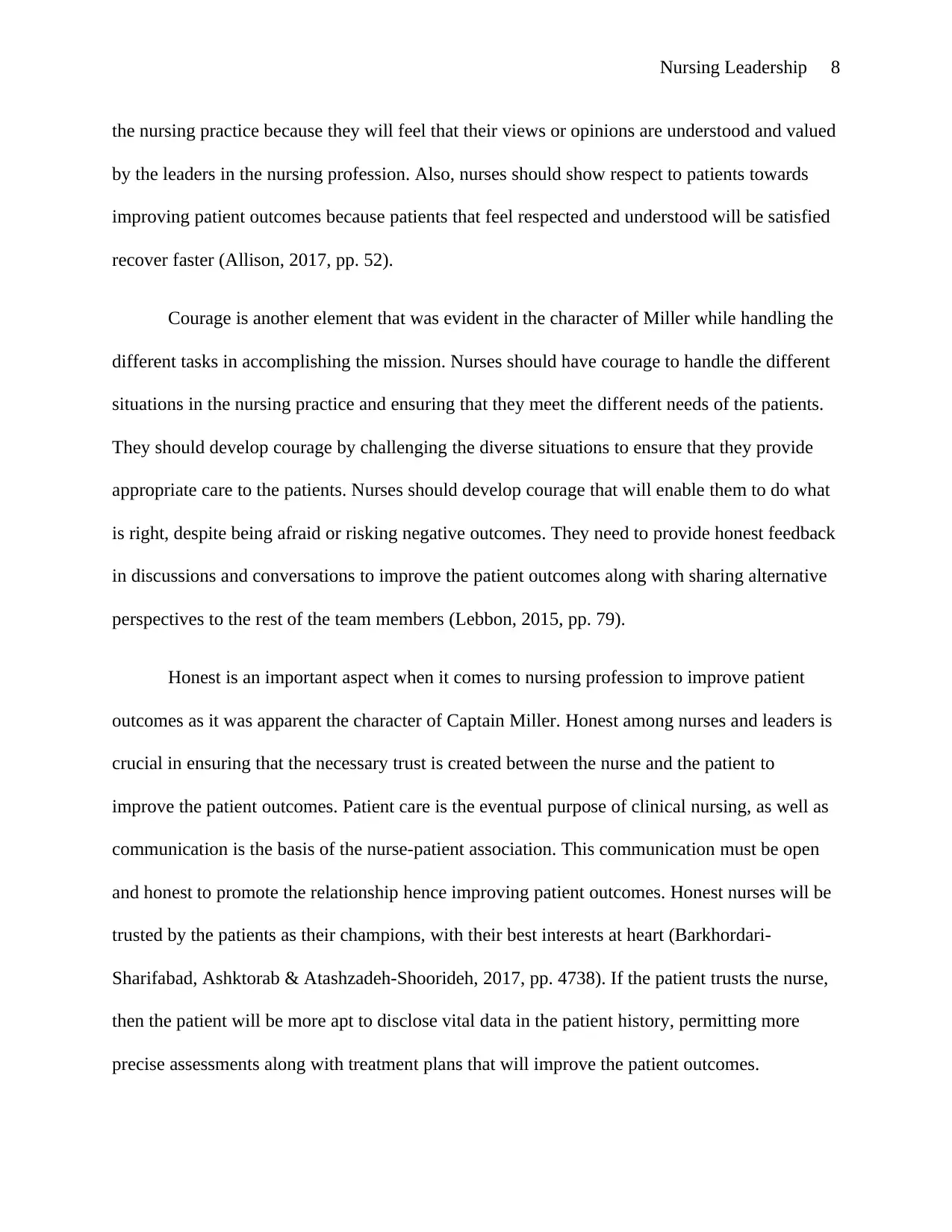
Nursing Leadership 8
the nursing practice because they will feel that their views or opinions are understood and valued
by the leaders in the nursing profession. Also, nurses should show respect to patients towards
improving patient outcomes because patients that feel respected and understood will be satisfied
recover faster (Allison, 2017, pp. 52).
Courage is another element that was evident in the character of Miller while handling the
different tasks in accomplishing the mission. Nurses should have courage to handle the different
situations in the nursing practice and ensuring that they meet the different needs of the patients.
They should develop courage by challenging the diverse situations to ensure that they provide
appropriate care to the patients. Nurses should develop courage that will enable them to do what
is right, despite being afraid or risking negative outcomes. They need to provide honest feedback
in discussions and conversations to improve the patient outcomes along with sharing alternative
perspectives to the rest of the team members (Lebbon, 2015, pp. 79).
Honest is an important aspect when it comes to nursing profession to improve patient
outcomes as it was apparent the character of Captain Miller. Honest among nurses and leaders is
crucial in ensuring that the necessary trust is created between the nurse and the patient to
improve the patient outcomes. Patient care is the eventual purpose of clinical nursing, as well as
communication is the basis of the nurse-patient association. This communication must be open
and honest to promote the relationship hence improving patient outcomes. Honest nurses will be
trusted by the patients as their champions, with their best interests at heart (Barkhordari-
Sharifabad, Ashktorab & Atashzadeh-Shoorideh, 2017, pp. 4738). If the patient trusts the nurse,
then the patient will be more apt to disclose vital data in the patient history, permitting more
precise assessments along with treatment plans that will improve the patient outcomes.
the nursing practice because they will feel that their views or opinions are understood and valued
by the leaders in the nursing profession. Also, nurses should show respect to patients towards
improving patient outcomes because patients that feel respected and understood will be satisfied
recover faster (Allison, 2017, pp. 52).
Courage is another element that was evident in the character of Miller while handling the
different tasks in accomplishing the mission. Nurses should have courage to handle the different
situations in the nursing practice and ensuring that they meet the different needs of the patients.
They should develop courage by challenging the diverse situations to ensure that they provide
appropriate care to the patients. Nurses should develop courage that will enable them to do what
is right, despite being afraid or risking negative outcomes. They need to provide honest feedback
in discussions and conversations to improve the patient outcomes along with sharing alternative
perspectives to the rest of the team members (Lebbon, 2015, pp. 79).
Honest is an important aspect when it comes to nursing profession to improve patient
outcomes as it was apparent the character of Captain Miller. Honest among nurses and leaders is
crucial in ensuring that the necessary trust is created between the nurse and the patient to
improve the patient outcomes. Patient care is the eventual purpose of clinical nursing, as well as
communication is the basis of the nurse-patient association. This communication must be open
and honest to promote the relationship hence improving patient outcomes. Honest nurses will be
trusted by the patients as their champions, with their best interests at heart (Barkhordari-
Sharifabad, Ashktorab & Atashzadeh-Shoorideh, 2017, pp. 4738). If the patient trusts the nurse,
then the patient will be more apt to disclose vital data in the patient history, permitting more
precise assessments along with treatment plans that will improve the patient outcomes.
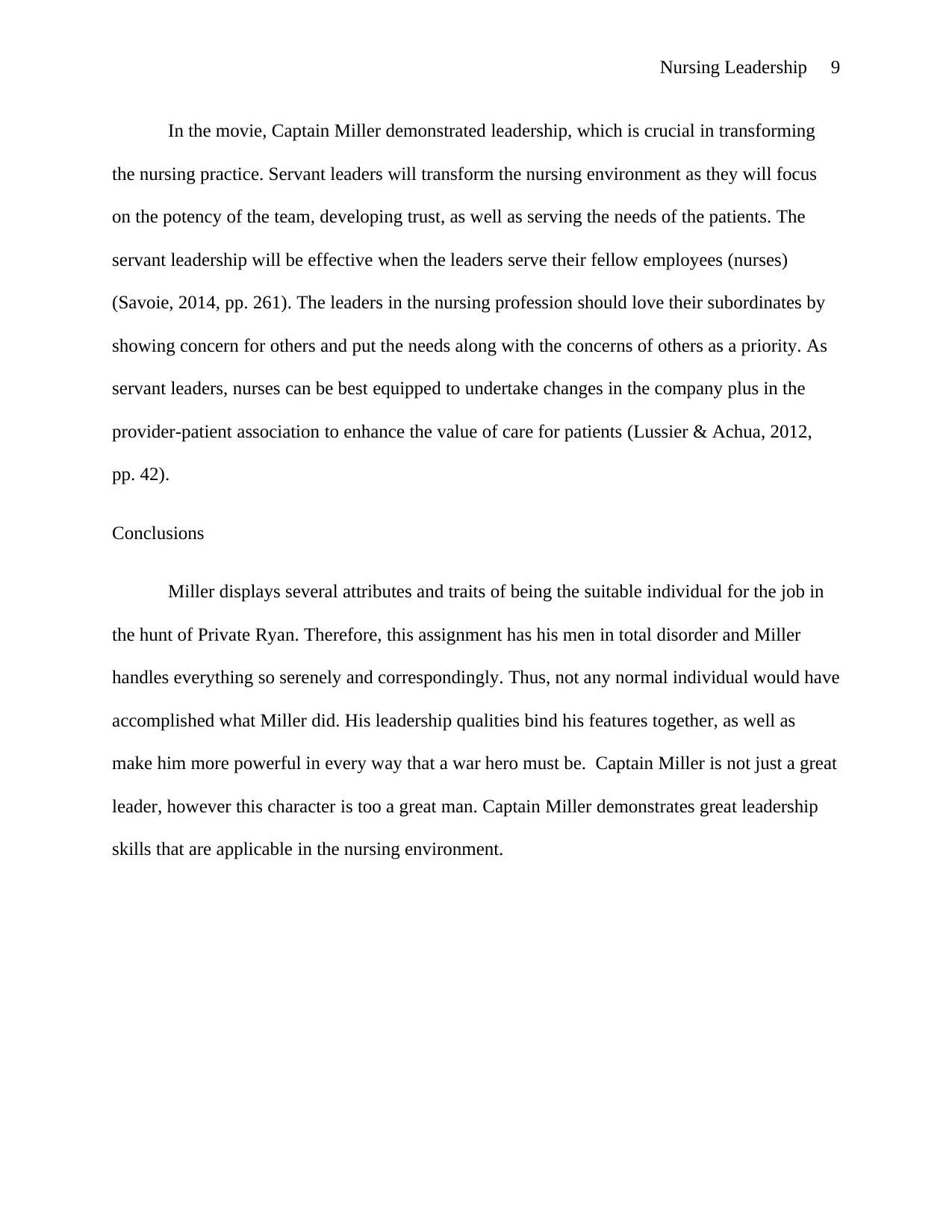
Nursing Leadership 9
In the movie, Captain Miller demonstrated leadership, which is crucial in transforming
the nursing practice. Servant leaders will transform the nursing environment as they will focus
on the potency of the team, developing trust, as well as serving the needs of the patients. The
servant leadership will be effective when the leaders serve their fellow employees (nurses)
(Savoie, 2014, pp. 261). The leaders in the nursing profession should love their subordinates by
showing concern for others and put the needs along with the concerns of others as a priority. As
servant leaders, nurses can be best equipped to undertake changes in the company plus in the
provider-patient association to enhance the value of care for patients (Lussier & Achua, 2012,
pp. 42).
Conclusions
Miller displays several attributes and traits of being the suitable individual for the job in
the hunt of Private Ryan. Therefore, this assignment has his men in total disorder and Miller
handles everything so serenely and correspondingly. Thus, not any normal individual would have
accomplished what Miller did. His leadership qualities bind his features together, as well as
make him more powerful in every way that a war hero must be. Captain Miller is not just a great
leader, however this character is too a great man. Captain Miller demonstrates great leadership
skills that are applicable in the nursing environment.
In the movie, Captain Miller demonstrated leadership, which is crucial in transforming
the nursing practice. Servant leaders will transform the nursing environment as they will focus
on the potency of the team, developing trust, as well as serving the needs of the patients. The
servant leadership will be effective when the leaders serve their fellow employees (nurses)
(Savoie, 2014, pp. 261). The leaders in the nursing profession should love their subordinates by
showing concern for others and put the needs along with the concerns of others as a priority. As
servant leaders, nurses can be best equipped to undertake changes in the company plus in the
provider-patient association to enhance the value of care for patients (Lussier & Achua, 2012,
pp. 42).
Conclusions
Miller displays several attributes and traits of being the suitable individual for the job in
the hunt of Private Ryan. Therefore, this assignment has his men in total disorder and Miller
handles everything so serenely and correspondingly. Thus, not any normal individual would have
accomplished what Miller did. His leadership qualities bind his features together, as well as
make him more powerful in every way that a war hero must be. Captain Miller is not just a great
leader, however this character is too a great man. Captain Miller demonstrates great leadership
skills that are applicable in the nursing environment.
⊘ This is a preview!⊘
Do you want full access?
Subscribe today to unlock all pages.

Trusted by 1+ million students worldwide
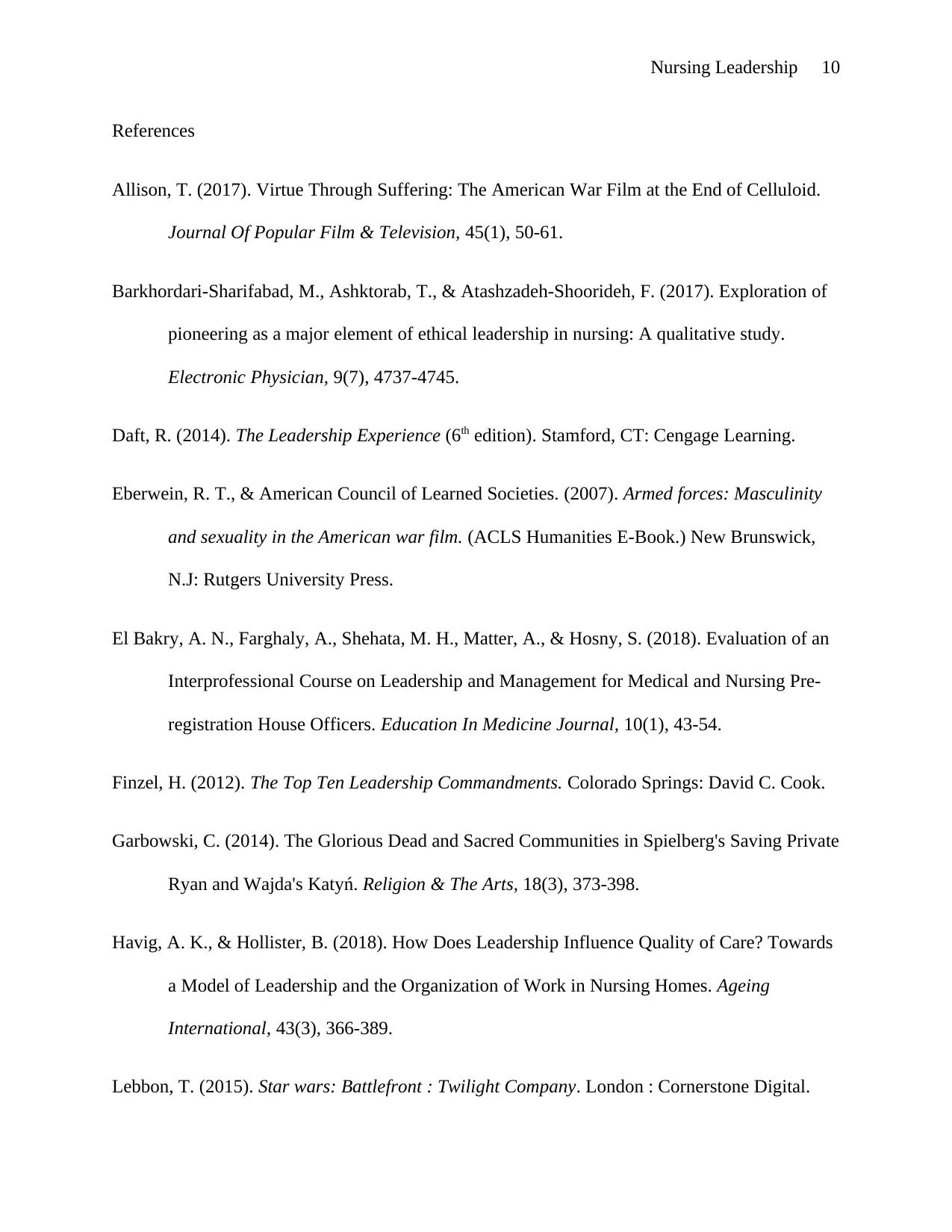
Nursing Leadership 10
References
Allison, T. (2017). Virtue Through Suffering: The American War Film at the End of Celluloid.
Journal Of Popular Film & Television, 45(1), 50-61.
Barkhordari-Sharifabad, M., Ashktorab, T., & Atashzadeh-Shoorideh, F. (2017). Exploration of
pioneering as a major element of ethical leadership in nursing: A qualitative study.
Electronic Physician, 9(7), 4737-4745.
Daft, R. (2014). The Leadership Experience (6th edition). Stamford, CT: Cengage Learning.
Eberwein, R. T., & American Council of Learned Societies. (2007). Armed forces: Masculinity
and sexuality in the American war film. (ACLS Humanities E-Book.) New Brunswick,
N.J: Rutgers University Press.
El Bakry, A. N., Farghaly, A., Shehata, M. H., Matter, A., & Hosny, S. (2018). Evaluation of an
Interprofessional Course on Leadership and Management for Medical and Nursing Pre-
registration House Officers. Education In Medicine Journal, 10(1), 43-54.
Finzel, H. (2012). The Top Ten Leadership Commandments. Colorado Springs: David C. Cook.
Garbowski, C. (2014). The Glorious Dead and Sacred Communities in Spielberg's Saving Private
Ryan and Wajda's Katyń. Religion & The Arts, 18(3), 373-398.
Havig, A. K., & Hollister, B. (2018). How Does Leadership Influence Quality of Care? Towards
a Model of Leadership and the Organization of Work in Nursing Homes. Ageing
International, 43(3), 366-389.
Lebbon, T. (2015). Star wars: Battlefront : Twilight Company. London : Cornerstone Digital.
References
Allison, T. (2017). Virtue Through Suffering: The American War Film at the End of Celluloid.
Journal Of Popular Film & Television, 45(1), 50-61.
Barkhordari-Sharifabad, M., Ashktorab, T., & Atashzadeh-Shoorideh, F. (2017). Exploration of
pioneering as a major element of ethical leadership in nursing: A qualitative study.
Electronic Physician, 9(7), 4737-4745.
Daft, R. (2014). The Leadership Experience (6th edition). Stamford, CT: Cengage Learning.
Eberwein, R. T., & American Council of Learned Societies. (2007). Armed forces: Masculinity
and sexuality in the American war film. (ACLS Humanities E-Book.) New Brunswick,
N.J: Rutgers University Press.
El Bakry, A. N., Farghaly, A., Shehata, M. H., Matter, A., & Hosny, S. (2018). Evaluation of an
Interprofessional Course on Leadership and Management for Medical and Nursing Pre-
registration House Officers. Education In Medicine Journal, 10(1), 43-54.
Finzel, H. (2012). The Top Ten Leadership Commandments. Colorado Springs: David C. Cook.
Garbowski, C. (2014). The Glorious Dead and Sacred Communities in Spielberg's Saving Private
Ryan and Wajda's Katyń. Religion & The Arts, 18(3), 373-398.
Havig, A. K., & Hollister, B. (2018). How Does Leadership Influence Quality of Care? Towards
a Model of Leadership and the Organization of Work in Nursing Homes. Ageing
International, 43(3), 366-389.
Lebbon, T. (2015). Star wars: Battlefront : Twilight Company. London : Cornerstone Digital.
Paraphrase This Document
Need a fresh take? Get an instant paraphrase of this document with our AI Paraphraser
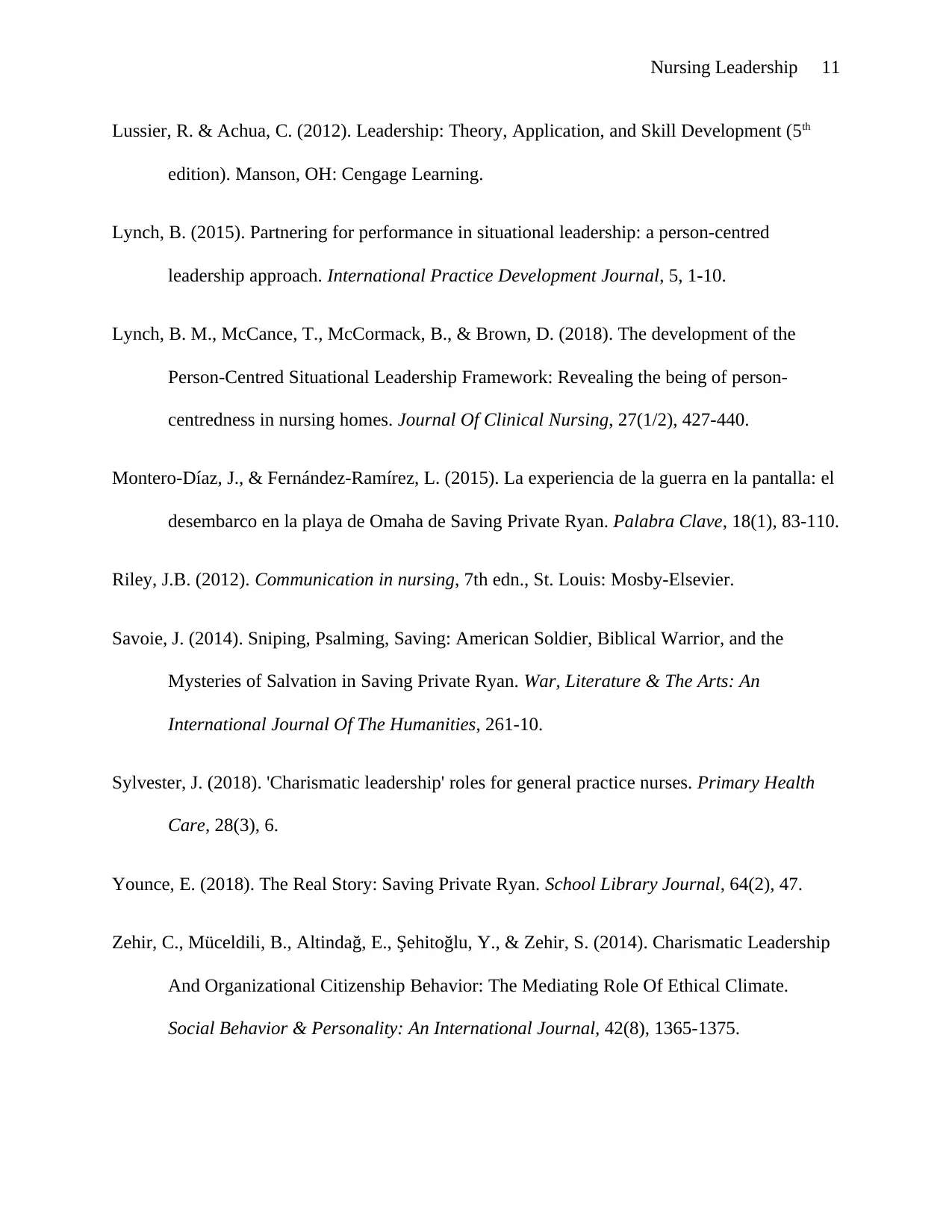
Nursing Leadership 11
Lussier, R. & Achua, C. (2012). Leadership: Theory, Application, and Skill Development (5th
edition). Manson, OH: Cengage Learning.
Lynch, B. (2015). Partnering for performance in situational leadership: a person-centred
leadership approach. International Practice Development Journal, 5, 1-10.
Lynch, B. M., McCance, T., McCormack, B., & Brown, D. (2018). The development of the
Person-Centred Situational Leadership Framework: Revealing the being of person-
centredness in nursing homes. Journal Of Clinical Nursing, 27(1/2), 427-440.
Montero-Díaz, J., & Fernández-Ramírez, L. (2015). La experiencia de la guerra en la pantalla: el
desembarco en la playa de Omaha de Saving Private Ryan. Palabra Clave, 18(1), 83-110.
Riley, J.B. (2012). Communication in nursing, 7th edn., St. Louis: Mosby-Elsevier.
Savoie, J. (2014). Sniping, Psalming, Saving: American Soldier, Biblical Warrior, and the
Mysteries of Salvation in Saving Private Ryan. War, Literature & The Arts: An
International Journal Of The Humanities, 261-10.
Sylvester, J. (2018). 'Charismatic leadership' roles for general practice nurses. Primary Health
Care, 28(3), 6.
Younce, E. (2018). The Real Story: Saving Private Ryan. School Library Journal, 64(2), 47.
Zehir, C., Müceldili, B., Altindağ, E., Şehitoğlu, Y., & Zehir, S. (2014). Charismatic Leadership
And Organizational Citizenship Behavior: The Mediating Role Of Ethical Climate.
Social Behavior & Personality: An International Journal, 42(8), 1365-1375.
Lussier, R. & Achua, C. (2012). Leadership: Theory, Application, and Skill Development (5th
edition). Manson, OH: Cengage Learning.
Lynch, B. (2015). Partnering for performance in situational leadership: a person-centred
leadership approach. International Practice Development Journal, 5, 1-10.
Lynch, B. M., McCance, T., McCormack, B., & Brown, D. (2018). The development of the
Person-Centred Situational Leadership Framework: Revealing the being of person-
centredness in nursing homes. Journal Of Clinical Nursing, 27(1/2), 427-440.
Montero-Díaz, J., & Fernández-Ramírez, L. (2015). La experiencia de la guerra en la pantalla: el
desembarco en la playa de Omaha de Saving Private Ryan. Palabra Clave, 18(1), 83-110.
Riley, J.B. (2012). Communication in nursing, 7th edn., St. Louis: Mosby-Elsevier.
Savoie, J. (2014). Sniping, Psalming, Saving: American Soldier, Biblical Warrior, and the
Mysteries of Salvation in Saving Private Ryan. War, Literature & The Arts: An
International Journal Of The Humanities, 261-10.
Sylvester, J. (2018). 'Charismatic leadership' roles for general practice nurses. Primary Health
Care, 28(3), 6.
Younce, E. (2018). The Real Story: Saving Private Ryan. School Library Journal, 64(2), 47.
Zehir, C., Müceldili, B., Altindağ, E., Şehitoğlu, Y., & Zehir, S. (2014). Charismatic Leadership
And Organizational Citizenship Behavior: The Mediating Role Of Ethical Climate.
Social Behavior & Personality: An International Journal, 42(8), 1365-1375.
1 out of 11
Your All-in-One AI-Powered Toolkit for Academic Success.
+13062052269
info@desklib.com
Available 24*7 on WhatsApp / Email
![[object Object]](/_next/static/media/star-bottom.7253800d.svg)
Unlock your academic potential
Copyright © 2020–2025 A2Z Services. All Rights Reserved. Developed and managed by ZUCOL.
